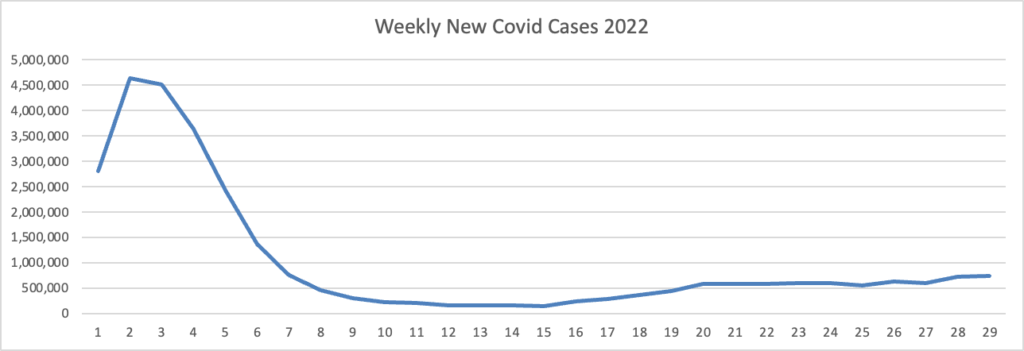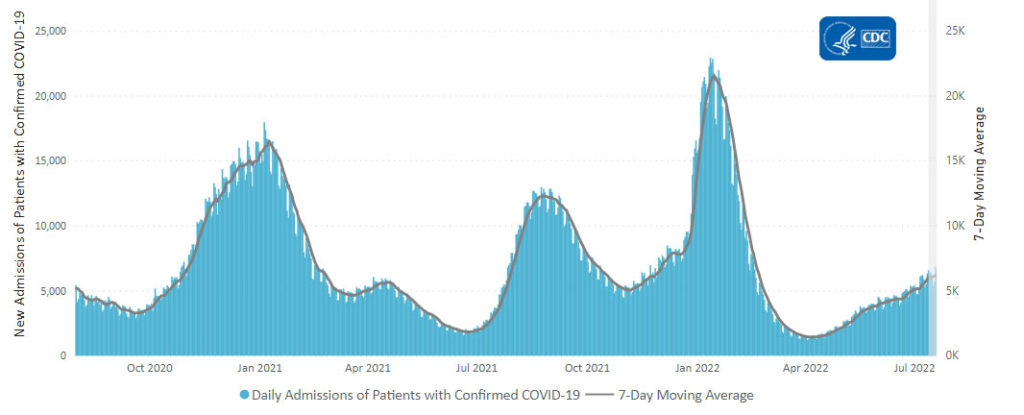Based on the CDC’s Covid Data tracker and using Thursday as the first day of the week, here is the FEHBlog’s weekly chart of new Covid cases for 2022:

Weeks 1 – 15 reflect the rise and fall of Omicron. The subsequent weeks reflect the ongoing attack of Omicron’s subvariants or siblings as the FEHBlog refers to them. Although the subvariants are more contagious than Omicron, the siblings haven’t come anywhere near the number of infections that Omicron produced in a rather short time.
The CDC’s weekly review of its Covid statistics notes “As of July 20, 2022, the current 7-day moving average of daily new cases (125,827) increased 0.5% compared with the previous 7-day moving average (125,185).”
Here’s the CDC’s Chart of Daily Trends in new Covid hospital admissions

The CDC’s weekly review points out “The current 7-day daily average for July 13–19, 2022, was 6,180. This is a 4.7% increase from the prior 7-day average (5,902) from July 6–12, 2022.”
Here’s the FEHBlog’s weekly chart of new Covid deaths for 2022:

The CDC’s weekly review adds “The current 7-day moving average of new deaths (348) has decreased 9.5% compared with the previous 7-day moving average (384).
Oddly enough, while hospitalizations are rising but deaths aren’t, STAT News reports
For many immunocompromised patients, Evusheld was supposed to offer salvation, a way of protecting people who couldn’t respond to vaccines because their T cells and B cells were impaired — perhaps by cancer, a genetic condition, or drugs taken for organ transplants. Many saw it as their path back to a pre-Covid life, or at least to seeing family and friends again after a two-year hermitage.
Yet eight months after the Food and Drug Administration first authorized the treatment, only a tiny fraction of the roughly 7 million patients who might be eligible have received it. Hundreds of thousands of doses sit on shelves in hospitals and infusion centers across the country, even as a new coronavirus variant rips through the population.
“I think it’s clear throughout the pandemic that lip service has been paid for protecting immunocompromised Americans, but actual policy delivery has failed time and time again,” said Matthew Cortland, a senior fellow at Data for Progress who has been tracking Evusheld distribution.
The manufacturer Astra-Zeneca has launched a direct-to-consumer ad campaign — the first for any Covid treatment.
Here’s the FEHBlog’s chart of Covid vaccinations distributed and administered from the beginning of the vaccination era — the 51st week of 2020 — through the 29th week of 2022:

The CDC’s weekly review comments
Overall, about 261.2 million people, or 78.7% of the total U.S. population, have received at least one dose of vaccine. About 223.0 million people, or 67.2% of the total U.S. population, have been fully vaccinated.* Of those fully vaccinated, about 107.5 million people have received a booster dose,** but 50.2% of the total booster-eligible population has not yet received a booster dose. * * *
According to CDC’s COVID Data Tracker, only about 34% of people who are eligible for a COVID-19 booster and about 29% of people ages 50 years and older who are eligible for a second booster have gotten one. Booster vaccination rates vary widely across the United States. In the Northeast and parts of the Midwest, 50% to 70% of eligible people have gotten a first booster in almost every county. Unfortunately, much of the Southeast and Southwest are in the 30% to 40% range.
Here’s the CDC’s community level report from the weekly review:
As of July 21, 2022, there are 1,350 (41.9%) counties, districts, or territories with a high COVID-19 Community Level, 1,212 (37.6%) counties with a medium Community Level, and 658 (20.4%) counties with a low Community Level. Compared with last week, this represents an increase (+6.5 percentage points) in the number of high-level counties, a decrease (−2.0) percentage points) in the number of medium-level counties, and a corresponding decrease (−4.5) percentage points) in the number of low-level counties. 50 out of 52 jurisdictions* had high- or medium-level counties this week. Rhode Island and Maine are the only jurisdictions to have all counties at low Community Levels.
To check your COVID-19 Community Level, visit COVID Data Tracker. To learn which prevention measures are recommended based on your COVID-19 Community Level, visit COVID-19 Community Level and COVID-19 Prevention.
Finally, STAT News explores the following conundrum: “‘There’s no one long Covid’: Experts struggle to make sense of the continuing mystery,” and David Leonhardt writing in the New York Times offered his clear eyed view of the Covid situation in yesterday’s column.
